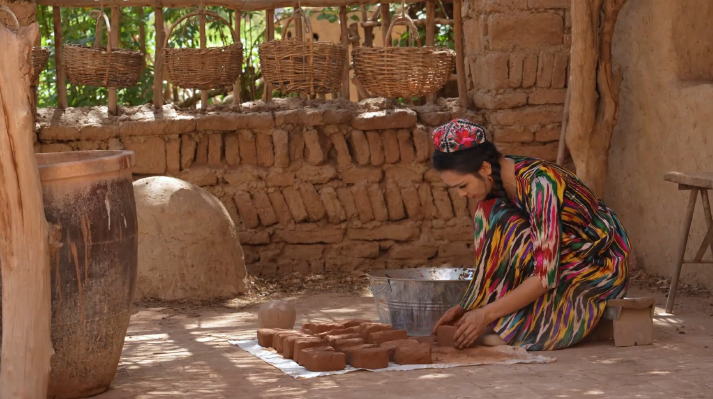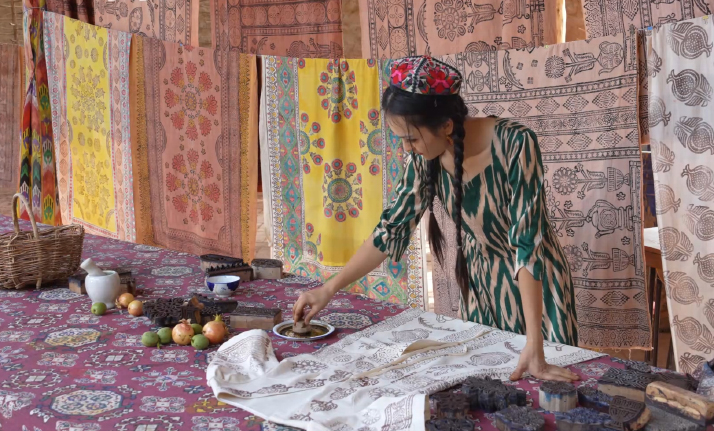| Xinjiang Today |
| Cultural heritage in pixels | |
|
|
 Zulhumar Ainiwar makes natural dye from fresh walnut husks and uses hand-carved wooden blocks to print traditional patterns on fabric (SCREENSHOT)
From Xinjiang's distinctive cuisine and handmade crafts to its rich intangible heritage, Gulixian's short videos are filled with the spirit of the region. Viewers follow her from the lively bustle of bazaars to the quiet rhythm of village life in her family's old courtyard, apricot orchards and vineyards, to the Karez, Xinjiang's ancient underground irrigation canals where she washes vegetables in the cool, flowing water, and to the tandoor oven, where she bakes fragrant flatbread by hand. All these in her videos yield a glimpse into the beauty of everyday Xinjiang. Gulixian is not the real name of the young woman in striking Uygur clothes who makes these videos. Her real name is Zulhumar Ainiwar, and she comes from Turpan, a fertile oasis in east Xinjiang. So far, she has made and shared hundreds of short videos rooted in Xinjiang's unique culture. Posted on platforms such as Douyin and Kuaishou, her work has attracted more than 400,000 followers on the Internet. Stories from Xinjiang Zulhumar studied at the College of Language and Literature at Henan University in central China, where she was at the top. After graduation, she chose to move to Beijing, where she worked for an education-focused Internet company. In three years, she had advanced from an intern to the company's regional manager for northwest China, proving her professional capabilities. However, after marriage and becoming a mother, she eventually returned to Turpan, where her priority was her child's education. But in her heart, she held on to her dreams. "When I came back to Turpan, platforms like Douyin and Kuaishou were only just starting to gain traction in Xinjiang, though they were already booming elsewhere," she recalled. "Since I worked in the Internet industry, I saw their potential." When she was working, Zulhumar specialized in producing short educational videos for teachers. This early exposure to video creation planted the seeds of her future career. Having lived and worked far from her home, Zulhumar gained a deep appreciation for China's rich cultural diversity. At the same time, she also sensed the curiosity and fascination people in other regions had about Xinjiang. In the beginning, she watched nearly every Xinjiang content creator she could find online. To her surprise, no one focused specifically on preserving and sharing traditional culture. "I really hoped someone from Xinjiang could fill that gap," she said. She kept a close eye on the trends in the industry; and long before Internet influencers like Li Ziqi from Sichuan in southwest China, who vlogs on food and handicraft making, became household names, she had noticed them. Watching Li Ziqi's work in preserving and sharing Chinese heritage left a strong impression on her and stirred her desire to showcase the culture of Xinjiang. "Xinjiang culture is a vital part of Chinese culture," she thought. "It's rich, colorful, and unique. It deserves its own storytellers." She decided to do it herself. For that, she decided to give herself time to prepare for it. She bought books about Xinjiang's culture, history, traditional crafts, classic literature and local cuisine. She immersed herself in studying the region's past and heritage and visited elderly villagers to collect stories and inspiration for her videos. "Turpan has an incredibly rich cultural heritage, with plenty of subjects worth documenting," Zulhumar said. "During that period, I was taking care of my child, researching Xinjiang's history, and writing scripts all at once. In two years, I finished more than 200 scripts. I kept thinking whether each idea truly represented cultural preservation, and then went on refining the drafts again and again. I never imagined I would actually appear on camera. I wasn't even comfortable being photographed—I hardly have any selfies on my phone!" But she eventually overcame her unease in front of the camera.  In the courtyard of her home, Zulhumar Ainiwar kneads clay by hand to make traditional earthen pots (SCREENSHOT)
Xinjiang's 'Li Ziqi' In 2022, Zulhumar started posting videos under the name Gulixian, which is a clever blend of cultural meaning and regional identity. Guli means flower in Uygur language, she explained. It's often used as a suffix in women's names and is also a way of praising women. Xian suggests something pure and good. Gulixian is a popular name for girls in Xinjiang. "This name comes from real life," she added. "Through the image of a beautiful Xinjiang woman, I want people to see the warmth and happiness here." Zulhumar was born and grew up in a small village full of warmth and close-knit neighbors, with adobe houses and stretches of grapevines. Her videos are grounded in everyday scenes of ordinary people in Xinjiang, showcasing traditional culture such as making paper from mulberry bark, block printing on fabric, and making pottery the old traditional way. Many of these skills are part of the region's national intangible cultural heritage. Because of her intensive preparations, Zulhumar didn't run into the common problem that plagues many content creators—"What should I film today?" Still, each video takes a long time to produce. Sometimes, the slow pace leads to loss of followers. To resolve this, she began to mix in videos about traditional Xinjiang food. This not only kept her audience engaged but also enabled her to showcase the region's diverse food culture. Since she has no formal production team, Zulhumar takes on multiple roles: She is her own scriptwriter, stylist, prop master and on-camera host. Behind her is a quiet pillar of support—her family. Her mother makes the traditional clothes she wears in the videos. "She has the traditional techniques, and I add modern design ideas to make the clothes more appealing," Zulhumar said. Her husband taught himself photography from scratch and became her go-to cameraman. Whenever she needs props or locations, the neighbors eagerly lend a hand, opening their courtyards, offering tools and doing whatever they can to help. The entire village has become part of the creative process. As her popularity grew, it was inevitable that there would be criticism as well. Some viewers accused her of copying Li Ziqi. She responded with calmness and clarity. "Li Ziqi inspired me, but what I do is fundamentally different," she said. "Her videos capture the poetic atmosphere of the south. I document the genuine, down-to-earth life of Xinjiang, especially how traditional skills are passed from generation to generation and adapted for modern life." "The Gulixian you see on camera is shaped by my mother—an ordinary rural woman who is hardworking, skilled and quietly resilient," she added. Zulhumar thinks the best way to dispel doubt is to keep creating content that shows her unique perspective. At the start of this year, she founded a company in Xinjiang, upgraded her filming equipment and refined her technique. She also started bringing in young people from nearby villages and trained them in video production and livestream selling, teaching them how to share Turpan's folk traditions and local products with a broader audience. "My team and I will find more lively and creative ways to present Xinjiang's culture and history online," Zulhumar said. "Through our lens, we also want to help expand the market for the agricultural products of our villages." Comments to zhangshsh@cicgamericas.com |
|
||||||||||||||||||||||||||||
|